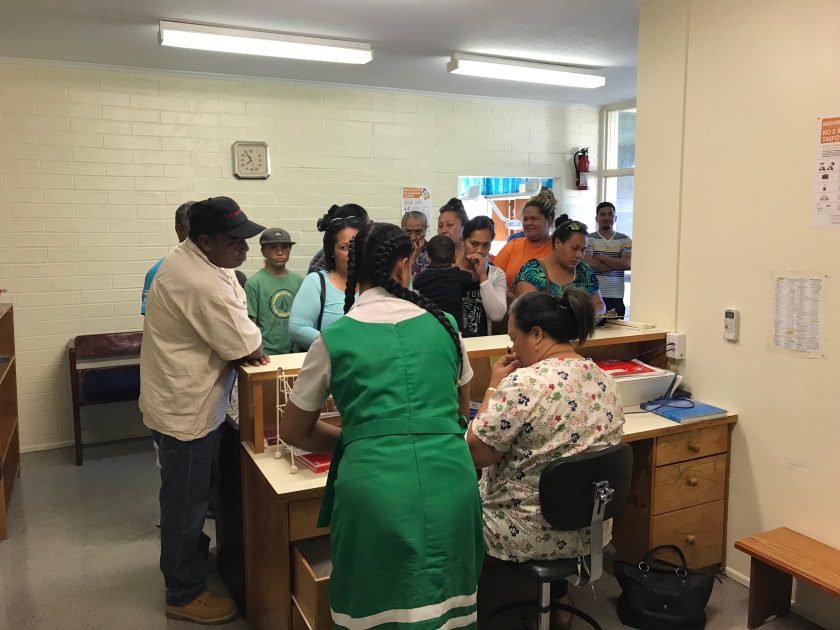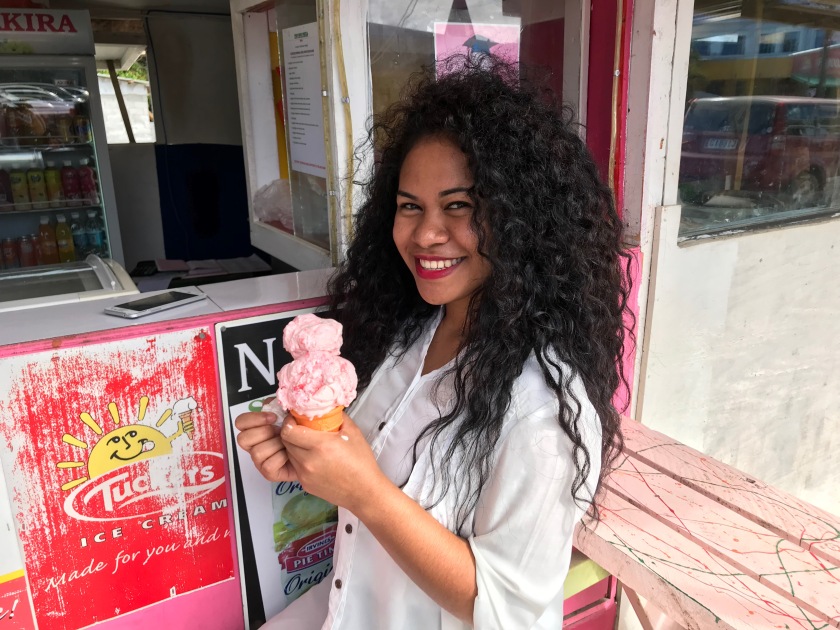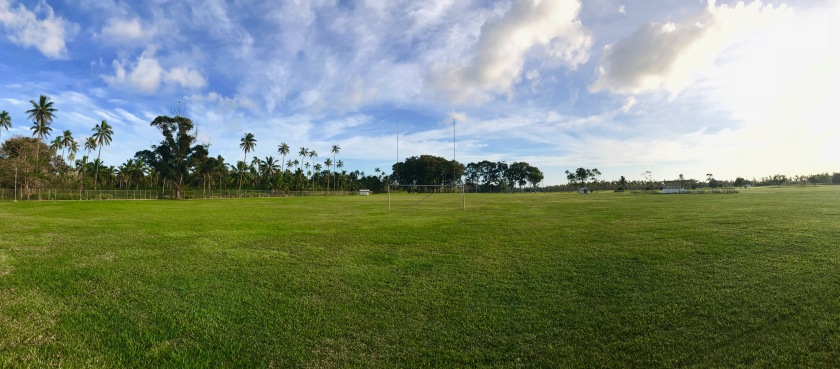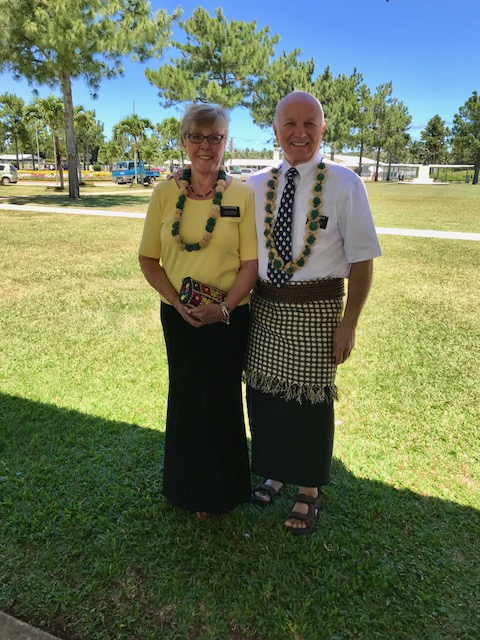We arrived in Tonga just three days ago, but it seems like we’ve been here for much longer. After arriving on Thursday afternoon, we had Friday to get settled in, Saturday to go to the open air market in Nuku ‘alofa to get much needed supplies, Sunday to attend our ward and spend some quiet time in the afternoon catching our breath, and then Monday (today) to hit the ground running and spend a full day in the clinic treating patients and learning routines.

This is what our clinic looks like each morning when we arrive.
It’s been a steep learning curve, that was compounded by my dropping my loupes on the floor this evening and cracking one of the magnification lenses. Luckily I have a couple of spare pairs of loupes, and I’m temped to just throw these in the garbage (but they did cost about $1,400.00). However, they do have a bifocal prescription that I no longer need (and that is an annoyance), the focal length is awkward, and the orientation of the magnification loupes to the “target” is off, so that I had to kind of cock my head to make them work. Additionally, I am hoping that the spare loupes that I will now be wearing won’t fog up so easily. So, having said all that, it was probably a blessing in disguise that they broke. The Lord works in mysterious ways.
We met with President Tuione this morning. He said he goes to outer islands frequently to visit the missionaries (about 100 of whom serve on the outer islands). He said he would like us to accompany him, so that we can meet the members and determine what their oral health care needs are. That will be fun.
We have also met a few more of the “Junior” missionaries. About half native Tongans and half “Palangi” (white people). They all wear the Tupeno. They all live in Missionary Quarters that are adjacent to chapels, that are found in every village on the island. Their “MQ”s are tiny. Generally one room about 15 feet square. They eat two meals a day (Tongan meals are enormous). Dinner at member’s homes are interesting. They prepare a feast, and serve the missionaries, but do not join in the meal, unless asked to do so. The members eat what is left over, and the missionaries have been cautioned by Pres. Tuione to leave some food for the members, because what they serve is what they would have eaten themselves if the missionaries had not been invited to dinner.
We are learning that this culture is very family oriented, and very traditional. Many of the customs are strange to us, however. For example, many male Tongan, even members of the Church, go to “Kava” parties. Kava is a powerful drink – almost a narcotic – that has been described as liquid novocaine. It dulls the senses and according to our High Priest Quorum instructor, who denounced the practice, it robs one of agency. At least it gives the person an excuse to act in ways he shouldn’t. Those who drink Kava leave to their wives the responsibility to care for their families. Some Tongans would rather drink Kava than work. (Kind of reminds me of Middle Easterners who sit and smoke narcotics from water pipes.)

This is not a Kava Party. This is a Tongan girl eating delicious New Zealand ice cream on the street in Nuku ‘alofa!
Having said that, and having been given just a glimpse of the appalling state of oral health in Tonga, I can see why they might want to drink Kava. I have seen teenagers 14 years old whose permanent teeth are decayed to the gum line, with nothing but black roots left. I did a pre-missionary exam today on an 18 year old, who will soon be out in the mission field, whose central and lateral incisors (maxillary arch) all needed root canals. Two of them were beyond restoration, and had to be extracted. I am hoping that when Midwestern Dental School comes in November, they will bring equipment so that they can at least make him a flipper partial to replace the missing teeth.
We have been told that the Church no longer sends Tongan missionaries to the U.S., Australia, or New Zealand. What was happening was they would serve their mission, and then go A.W.O.L. when it was time to get on the plane and return home. They would just disappear – they couldn’t face the prospect of returning to Tonga, where there is little opportunity for education or decent jobs. I’m beginning to realize that this is a problem all across the South Pacific (and probably in most third-world countries).
I am sure the church is doing what it can – the Senior Missionaries here are Humanitarian, Self-Reliance, Medical, Dental, Physical Facilities, and Educational, but the scope of need is almost incomprehensible.
Having said all that, when we went to Church on Sunday, there was a great spirit in the meetings, and the members seemed happy. I think they are grateful for their blessings, and are not concerned about temporal things. Most of them have never been off the island, and probably have little idea what life is like (temporally) in the U.S.. The people in the open-air market on Saturday are a good example. They were all busy selling their fruits, vegetables, poultry and fish, and handicrafts, and getting ready for the biggest day of the week: Sunday, which is a family day. They probably have their priorities in order more than a lot of people who happen to have a lot more temporal wealth.
 We walk past this playing field on the Liahona Campus on our way to the clinic from our house.
We walk past this playing field on the Liahona Campus on our way to the clinic from our house.
The villages here are certainly not fancy – homes are basic, and construction is rudimentary, but yards are relatively clean and I haven’t seen any small children selling chicklets on the street. However, they haven’t quite grasped the concept of not littering. They do seem to toss their trash on the ground (and on the beach) without much regard for the environment. They DESPERATELY need a waste-to-energy plant (which they do not have on the island) because power is generated by oil, (or some solar panels),and trash goes into landfills. (Again – third world mentality. Think: China and coal-fueld power plants.)
They say that if you push a stick into the ground, in a couple of months there will be a flourishing plant growing with abundant fruit hanging from its branches. There are mango trees, papaya, breadfruit, banana, watermelon, etc. everywhere, and fruit stands lining the roads. Many people live ‘in the bush” off the land and the sea. Large Mexican papaya are $.50 (U.S.). A large watermelon is $1.50 (U.S.).


I love all of your pictures! And your blog. Thank you!
LikeLike